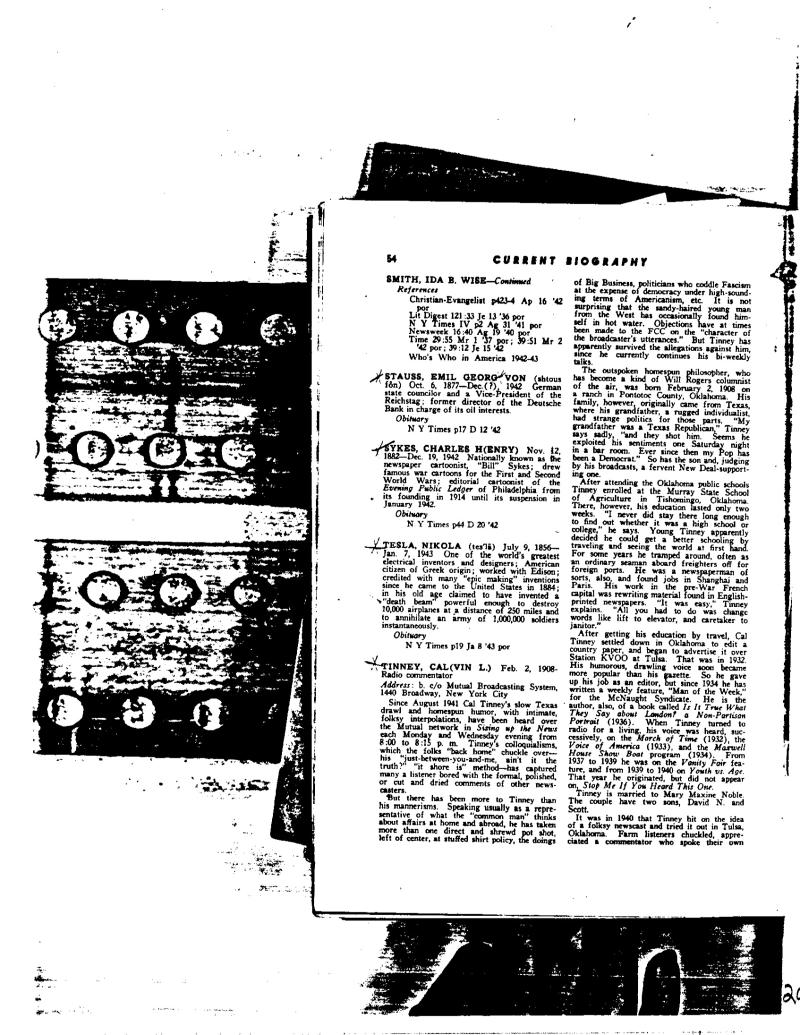
Nikola Tesla Documents
Nikola Tesla FBI Files - Page 209
*.... . E-X 54 SMITH, IDA B. WISE-Continued References CURRENT Christian-Evangelist p423-4 Ap 16 42 por Lit Digest 121:33 Je 13 '36 por NY Times IV p2 Ag 31 41 por Newsweek 16:40 Ag 19 40 por Time 29:55 Mr 1 37 por; 39:51 Mr 2 '42 por: 39:12 Je 15 42 Who's Who in America 1942-43 STAUSS, EMIL GEORG VON (shtous fôn) Oct. 6, 1877-Dec. (?), 1942 German state councilor and a Vice-President of the Reichstag; former director of the Deutsche Bank in charge of its oil interests. Obituary NY Times p17 D 12 '42 SYKES, CHARLES H(ENRY) Nov. 12, 1882 Dec. 19, 1942 Nationally known as the newspaper cartoonist, "Bill" Sykes; drew famous war cartoons for the First and Second World Wars; editorial cartoonist of the Evening Public Ledger of Philadelphia from its founding in 1914 until its suspension in January 1942. Obituary NY Times p44 D 20 '42 XTI TESLA, NIKOLA (teslä) July 9, 1856Jan. 7, 1943 One of the world's greatest electrical inventors and designers; American citizen of Greek origin; worked with Edison; credited with many "epic making" inventions since he came to the United States in 1884; in his old age claimed to have invented a "death beam" powerful enough to destroy 10,000 airplanes at a distance of 250 miles and to annihilate an army of 1,000,000 soldiers instantaneously. Obituary NY Times p19 Ja 8 '43 por TINNEY, CAL(VIN L.) Feb. 2, 1908Radio commentator Address: b. c/o Mutual Broadcasting System, 1440 Broadway, New York City Since August 1941 Cal Tinney's slow Texas drawl and homespun humor, with intimate, folksy interpolations, have been heard over the Mutual network in Siring up the News each Monday and Wednesday evening from 8:00 to 8:15 p. m. Tinney's colloquialisms, which the folks "back home" chuckle overhis "just-between-you-and-me, ain't it the truth?" "it shore is" method-has captured many a listener bored with the formal, polished, or cut and dried comments of other newscasters. But there has been more to Tinney than his mannerisms. Speaking usually as a representative of what the "common man" thinks about affairs at home and abroad, he has taken more than one direct and shrewd pot shot, left of center, at stuffed shirt policy, the doings þar kemu BIOGRAPHY of Big Business, politicians who coddle Fascism at the expense of democracy under high-sounding terms of Americanism, etc. It is not surprising that the sandy-haired young man from the West has occasionally found himself in hot water. Objections have at times been made to the FCC on the "character of the broadcaster's utterances." But Tinney has apparently survived the allegations against him, since he currently continues his bi-weekly talks. The outspoken homespun philosopher, who has become a kind of Will Rogers columnist of the air, was born February 2, 1908 on a ranch in Pontotoc County, Oklahoma. His family, however, originally came from Texas, where his grandfather, a rugged individualist, had strange politics for those parts. "My grandfather was a Texas Republican," Tinney says sadly, "and they shot him. Seems he exploited his sentiments one Saturday night in a bar room. Ever since then my Pop has been a Democrat." So has the son and, judging by his broadcasts, a fervent New Deal-supporting one. After attending the Oklahoma public schools Tinney enrolled at the Murray State School of Agriculture in Tishomingo, Oklahoma. There, however, his education lasted only two weeks. "I never did stay there long enough to find out whether it was a high school or college," he says. Young Tinney apparently decided he could get a better schooling by traveling and seeing the world at first hand. For some years he tramped around, often as an ordinary seaman aboard freighters off for foreign ports. He was a newspaperman of sorts, also, and found jobs in Shanghai and Paris. His work in the pre-War French capital was rewriting material found in Englishprinted newspapers. "It was easy," Tinney explains, "All you had to do was change. words like lift to elevator, and caretaker to janitor." After getting his education by travel, Cal Tinney settled down in Oklahoma to edit a country paper, and began to advertise it over Station KVOO at Tulsa. That was in 1932. His humorous, drawling voice soon became more popular than his gazette. So he gave up his job as an editor, but since 1934 he has written weekly feature, "Man of the Week," for the McNaught Syndicate. He is the author, also, of a book called Is It True What They Say about London? a Non-Partisan Portrait (1936). When Tinney turned to radio for a living, his voice was heard, successively, on the March of Time (1932), the Voice of America (1933), and the Marwell House Show Boat program (1934). From 1937 to 1939 he was on the Vanity Fair feature, and from 1939 to 1940 on Youth vs. Age. That year he originated, but did not appear on, Stop Me If You Heard This One. Tinney is married to Mary Maxine Noble. The couple have sons, David and Scott. It was in 1940 that Tinney hit on the idea of a folksy newscast and tried it out in Tulsa, Oklahoma. Farm listeners chuckled, appreciated a commentator who spoke their own pa ka parapijos p ¡ I
